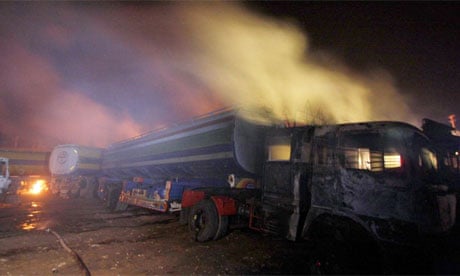Louis Berger, a major construction company headquartered in New Jersey, has agreed to pay out a record $69.3m in fines (pdf), the largest ever such penalty imposed on a contractor working in the war zones of Afghanistan and Iraq. The company has been awarded billions of dollars in contracts for the construction of roads, schools and electrical plants in Afghanistan.
Harold Salomon, a former senior financial analyst at the company, discovered that company officials were sending bills for items like the cost of the music system in its Washington, DC office to the US Agency for International Development (USAID). Salomon blew the whistle on estimated overcharging of up to $20m and took the company to court with the help of Phillips & Cohen, a trial law firm in Washington, DC.
"Today I can affirm to those who told me the Louis Berger Group can get away with anything that they were wrong," Salomon said in a press statement, when the settlement was announced on 5 November. "To those who said, 'If you cannot beat them, you have to join them,' I say they were wrong, too."
Louis Berger's work in Afghanistan was first heavily criticised in a 2006 report by Fariba Nawa of CorpWatch titled "Afghanistan, Inc." (full disclosure: I commissioned this report when I worked at CorpWatch). Nawa described a clinic in Qala Qazi built by Louis Berger, which she had visited, that was falling apart:
"The ceiling had rotted away in patches; the plumbing, when it worked, leaked and shuddered; the chimney, made of flimsy metal, threatened to set the roof on fire; the sinks had no running water; and the place smelled of sewage."
Louis Berger also advised USAID on a road from Sar-e Paul province and Shiberghan, the capitol of Jawzjan province, which Nawa also visited. The highway did not have shoulders for emergency stops, gravel on the road caused their car punctures and broke windshields, and the runoff from the raised road was flooding local homes. A petition, signed by 1,000 local residents, was delivered to the local governor, but since the road was paid for by Washington, the governor was unable to do anything.
"On a programme of this magnitude, there will be problems; the challenges in Afghanistan make it even more difficult. There will be disagreements and mistakes made by anybody at any given time. However, you overcome those problems and you keep the objectives in mind and move forward," Fred Chace, deputy operations manager for Berger in Afghanistan, wrote in an email to Nawa when she asked for explanations of these problems in November 2005.
Five years later, the company has admitted that its employees were overcharging the government at about the same time. "When the company identified issues with its allocations to the federal government for projects overseas, it began refunding the government in addition to implementing a companywide internal improvement programme," asserted company spokesperson Holly Fisher in an official statement last week.
Despite this investgation and settlement, a slew of new reports from the special inspector general for Afghanistan (Sigar) suggests that the US government still does not have a full grasp of what happens to the billions of dollars that are being funnelled into Afghanistan today. Between 2007 and 2009, the Pentagon, the state department and USAID approved nearly $18bn to nearly 7,000 contractors. According to an October 2010 audit by Sigar, they cannot readily account for this expenditure: "If we don't even know who we're giving money to, it is nearly impossible to conduct system wide oversight," said Major General Arnold Fields, director of Sigar.
A second audit issued by Sigar last month showed that "six Afghan National Police (ANP) facilities funded by the US Army Corps of Engineers (USACE) in the strongholds of Kandahar and Helmand are so poorly constructed, they are currently unusable." And a third audit by Sigar issued at the same time reported that the "US government is unable to determine how much money it has given the Afghan government in salary supplements since 2002, or how many recipients are being paid."
The litany of financial mismanagement goes on. In a fourth audit issued by Sigar in October, investigators reported that Nangarhar province in eastern Afghanistan was receiving millions of dollars in aid which local government officials were unable to properly oversee. "This haphazard approach to development assistance results in overlapping, or duplicate, projects, and also a lack of much-needed facilities because donors funnelling in millions of dollars do not know what specific projects the various donor countries are responsible for," Maj Gen Fields reported. "This is a recipe for a disaster, and a recipe for tremendous waste of money and resources."
Nine years after the invasion of Afghanistan, one has to ask the questions: why is there no proper way to manage money in Nangarhar (where the US has a major military base); why are police stations in Helmand and Kandahar (the two provinces with the largest military operations) unusable; and why is there, apparently, no way to tell whether or not the government salaries are being paid out properly; and what, finally, has happened to the last 18bn of US taxpayers' dollars spent in the country?
Yet, reconstruction funding is only part of the problem in Afghanistan. An estimated $14bn a year has been spent by the Pentagon and Nato on contractors to build bases and drive fuel trucks. Some of that money is believed to leak out into the hands of insurgent groups like the Taliban, according to an investigation conducted by the US Congress.
The Pentagon has appointed a special group called Task Force 2010 to follow those billions. The answers to where the money has gone aren't necessarily going to be made public by the Pentagon, in which case American taxpayers may have to hope there will be another Harold Salomon willing to put the information in the public domain via WikiLeaks or trial lawyers like Phillips & Cohen.
